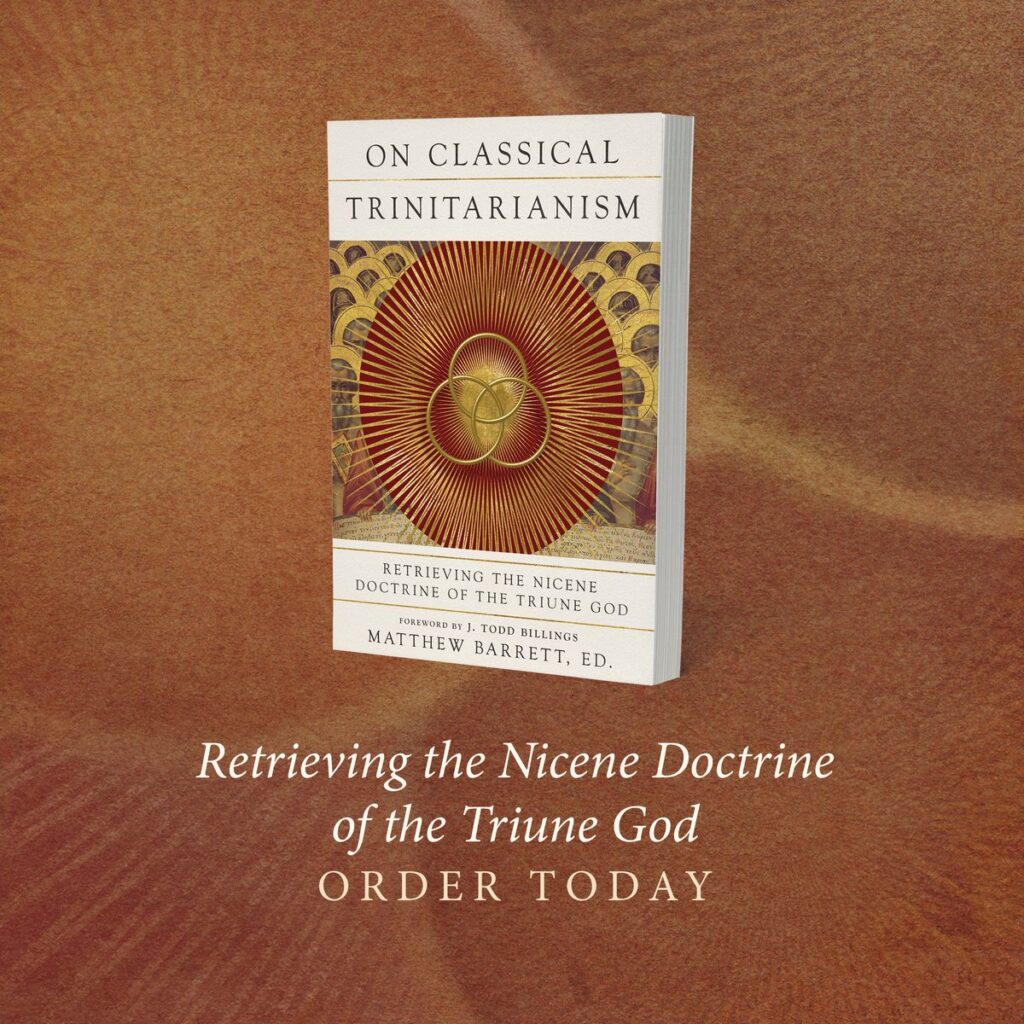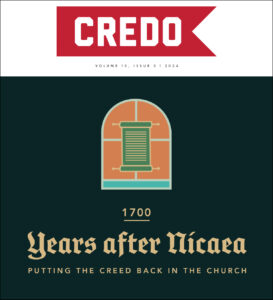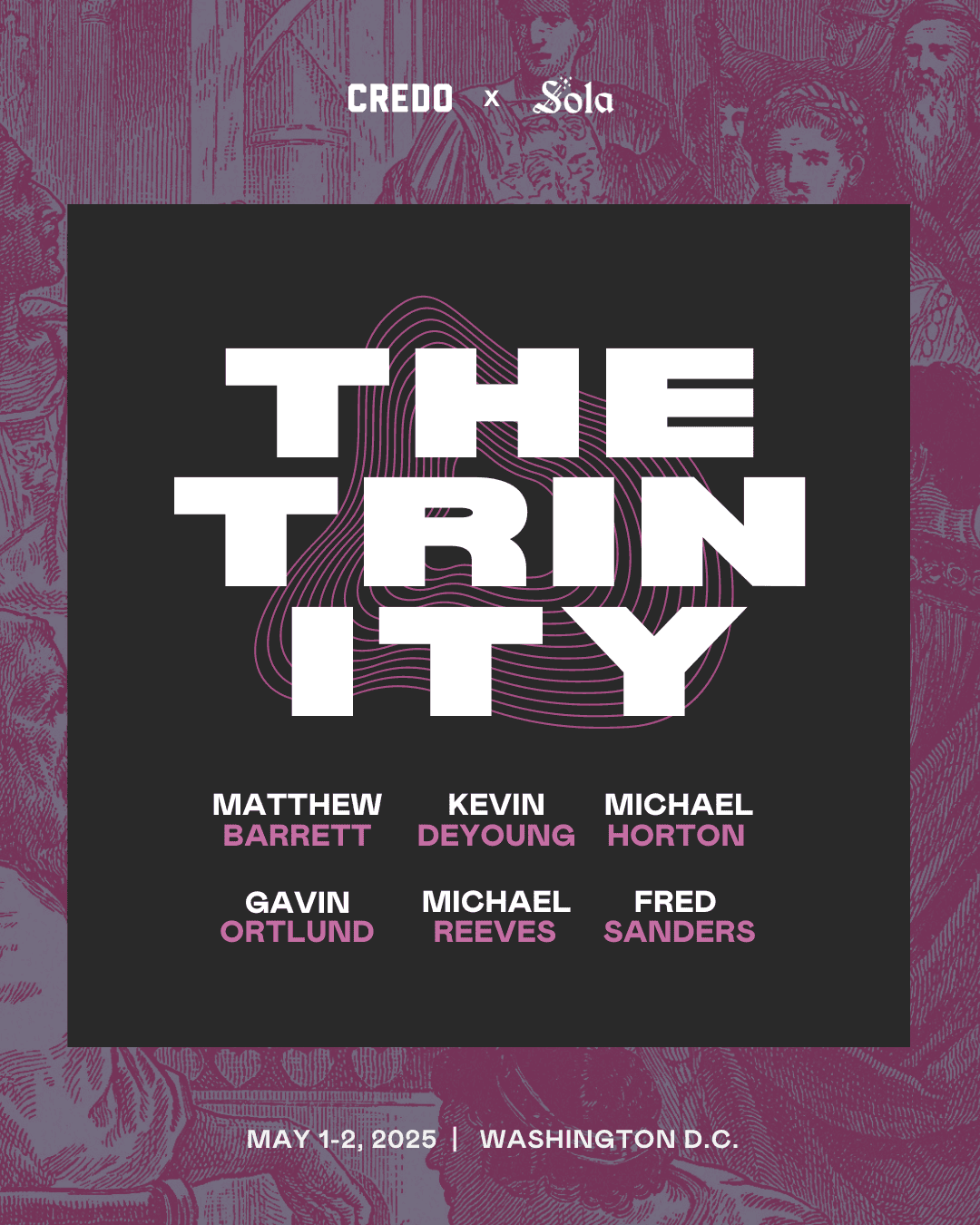 On Classical Trinitarianism: Retrieving the Nicene Doctrine of the Triune God (IVP Academic), edited by Matthew Barrett, winner of The Gospel Coalition Book Award in Theological Studies and the Southwestern Journal of Theology Top Honor in Church History/Historical Theology/Biography, brings together 40 of today’s best theologians to recover Nicene Orthodoxy in the church today. This ecumenical work seeks to counter the rise of social trinitarianism in all its guises by emphatically reintroducing Classical commitments while summoning readers to see the grandeur of God as articulated through the Great Tradition. Each chapter is a master class in historical theology, Scriptural exegesis, and dogma for the sake of the Church. In this interview, a few contributors share the specific aim of their chapter.
On Classical Trinitarianism: Retrieving the Nicene Doctrine of the Triune God (IVP Academic), edited by Matthew Barrett, winner of The Gospel Coalition Book Award in Theological Studies and the Southwestern Journal of Theology Top Honor in Church History/Historical Theology/Biography, brings together 40 of today’s best theologians to recover Nicene Orthodoxy in the church today. This ecumenical work seeks to counter the rise of social trinitarianism in all its guises by emphatically reintroducing Classical commitments while summoning readers to see the grandeur of God as articulated through the Great Tradition. Each chapter is a master class in historical theology, Scriptural exegesis, and dogma for the sake of the Church. In this interview, a few contributors share the specific aim of their chapter.
What does dogmatics look like after Nicaea and does dogmatics today need the Nicene Creed?
Glenn Butner: My chapter explores theological objections to the eternal submission of the Son. This is an evangelical theological error common since the mid-twentieth century that claims the Son submits to the Father within the eternal relations of the Trinity, often using this submission as the basis for complementarian gender roles or even as the basis for distinguishing the divine persons. I have argued that this perspective violates longstanding theological association of wills and operations with natures. If will is associated with nature, this would require that the Trinity have a single will, making submission impossible. I made the case in an earlier book – The Son who Learned Obedience: A Theological Case Against the Eternal Submission of the Son (Pickwick, 2018) – that associating will with hypostasis instead of nature is catastrophic for the doctrines of the Trinity, Christology, and the atonement. I restate that case in this chapter, but I pay more attention to objections to my arguments that have arisen in the past six years. I’ll summarize briefly two of my responses. First, like many in the great tradition, I argue that Christ had two wills, one for each nature (a position known as dyothelitism). Those who support the eternal submission of the Son have objected that this is Nestorianism. In my chapter I respond by showing that dyothelitism offers a much more robust account of the unity of the human and divine natures of Christ than does either Nestorianism or the doctrine of eternal submission. Second, many who defend eternal submission claim that this belief follows necessarily from the doctrine of eternal generation. Against this claim, I argue that the traditional doctrine of eternal generation cannot accommodate the idea of submission, and that Wayne Grudem and Bruce Ware’s use of eternal generation to defend eternal submission results in an incoherent doctrine of the Trinity. I’m happy with the result of my argument, and this is probably my most forceful rebuttal of the doctrine of eternal submission.
Were the Reformers and post-Reformation Reformed theologians creedal critics or confessors?
J.V. Fesko: There are some events in Reformation history as well as recent reticence in 20th century Reformed theology that might lead some to doubt the claim that 16th and 17th century Reformed theologians confidently confessed the early church creeds. Some have argued that the Reformers were not purveyors of stagnant and speculative church tradition but engaged in fresh exegesis of the Scriptures to produce a uniquely biblical doctrine of Christ in its articulation of his person, in his divinity and humanity. This essay explores those claims and dispels the doubts about the early modern Reformed tradition to demonstrate that theologians of this period were indeed creedal confessors. They joined hands with the ancient church to profess the faith once delivered to the saints, a faith that is both biblical and creedal as they professed the christology of Nicaea, Constantinople, Ephesus, and Chalcedon.
How does your chapter, “The Trinity is Still Not Our Social Program,” address the theological error of Eternal Functional Subordinationism (EFS)?
Samuel Parkison: My specific critique is in EFS’s programmatic approach of making gender discussions agenda-setting for Trinitarian theology. By inverting the theological principle John Webster so helpfully summarized—namely, that theology is about God and all things in relation to God—EFS leaves us with an un-theological theology of the Holy Trinity. To make this case, I first offer an initial summary of EFS and its historical origins. I provide a preliminary critique of the system as a whole before moving more specifically into a consideration of the substantial errors EFS commits in the areas of theology proper and Christology, as well as the implications for soteriology. Since EFS inverts theological theology and subjects God’s inner life to a social program, EFS cannot but have a radically detrimental impact on all areas of theology. I then take a closer look at several key “proof texts” for EFS advocates, and demonstrate how a Classical Trinitarian theology and hermeneutic offers a better reading of Holy Scripture. In the end, I contend that EFS’s tinkering with the Trinity is not only grossly inappropriate from a theological point of view, but is also entirely unnecessary to arrive at the social conclusions it intends. Something very much like complementarianism was assumed for the better part of the Churches history, though she never felt compelled to argue for distinct gender roles from Trinitarian theology. The theological loci of creation (“male and female he created them”) and soteriology (“husbands, love your wives as Christ loved the church”) are more than sufficient to bolster a conservative account of gender relations. EFS, I conclude, should be rejected root and branch. Or, more colloquially stated, “if it ain’t broke, don’t fix it!”
How have metaphysical departures from classical trinitarianism created a revisionist tendency today?
Craig Carter: In my chapter I seek to advance the discussion initiated by theologians such as Lewis Ayres and Stephen Holmes on the topic of twentieth century Trinitarian theology. They point out that the so-called “revival” of Trinitarian theology in the twentieth century was more of a drastic “revision” of classical, Nicene Trinitarian theology. There have been many departures from historic Nicene theology proper such as denials of attributes like simplicity, immutability, and impassibility, as well as social Trinitarianism, open theism, panentheism, theistic personalism, eternal functional subordination of the Son, and so on. Is there any principle or common thread that ties all these varied departures from classical Trinitarianism together? I propose that behind all these revisions lies an attempt to revise a doctrine, which was originally defined on the basis of classical realist metaphysics, expressed most brilliantly by Thomas Aquinas, to fit within the parameters of an entirely new metaphysics, which arose in modernity and flourished in the eighteenth and nineteenth centuries. The classical doctrine of the Triune God is so intricately bound up with the metaphysics of Plato and Aristotle, as brought together in a creative synthesis by Thomas, that it tends to grow sickly and die when removed from that rich and deep soil and transplanted into the thin, shallow metaphysical soil of modernity. This explains why both conservative theologians fare no better than their liberal counterparts in maintaining the tradition. Insofar as one tries to think from within the naturalism of modernity after Kant and Hegel one inevitably revises the traditional doctrine and the only question is whether that revision will be major or minor.
How does your chapter unpack the implications of Nicaea’s doctrine of eternal generation?
Fred Sanders: One of the great things about being part of a shared project is that I know I can rely on other team members to carry some of the load. Since I knew that somebody else was thoroughly covering eternal generation from the exegetical and biblical-theology point of view, I was free to devote my whole chapter to how the doctrine works within the structure of a theological system. My main argument is that Nicaea’s doctrine of eternal generation has the function of telling us exactly what we mean by “Son” when we call Jesus Christ the Son of God. He’s not just any kind of son, but this highly specific (indeed, unique) kind: one who is always from the Father, who is of the same essence as the Father, and is fully equal with the Father. Part of my chapter shows how the Nicene Creed calls Jesus the Son and then says in nine different ways–yes, nine!–what it means by Son. He is begotten, begotten from the Father, begotten before all worlds, begotten rather than made, begotten as light from light, true God from true God, and so on. Later in the chapter I let Baptist theologian John Gill (circa 1750) explain how every other possible meaning of “sonship” has to be based on the foundation of eternal generation. I hope the chapter is engaging and fresh, but not original. The one thing that may strike some readers as a new way of thinking about this doctrine is that I say eternal generation faces two directions: looking at its Christ-ward aspect, it obviously shows that the Son is co-eternal, co-essential, and co-equal with the Father. So it makes good Christology. But looking at eternal generation’s God-ward aspect, it shows that God is precisely the God who has a Son, or rather, who is Father and Son in the unity of the Holy Spirit, by nature. So eternal generation also makes a good doctrine of God.
What kind of influence did the Cappadocians have on trinitarian theology?
Stephen Hildebrand: My essay posits that Cappadocian trinitarian vocabulary brings the New Testament’s teaching on God, Father, Son, and Holy Spirit, to maturity and clarity. In their thought, scriptural revelation remains primary, and technical words may be necessary and helpful, but they are secondary to the truth that is communicated in Scripture and by the Fathers, often without these technical terms. The truths that emerge in this consideration of the Cappadocians help us to avoid two key mistakes prominent in contemporary trinitarian theology. First, for them, human language applied to God is at once truly communicative and yet inadequate to comprehend the divine mystery. They do not fall into the mistake conditioning human language to the point that we are forced from a humble apophaticism (the Cappadocian view) to a radical agnosticism that undercuts the message of the Gospel. Secondly, for the Cappadocians, while the social analogy—Father, Son, and Holy Spirit are like Peter, James, and John—can be instructive, it is not taken so far as to anthropomorphize God and compromise his transcendence.
Are Evangelicals Nicene Trinitarians?
D. Blair Smith: Social Trinitarianism (ST) is commonly associated with more mainline forms of Christianity. However, ST has had a significant presence within Evangelicalism since the 1980s and 1990s. My chapter reveals this presence on both the theological “left” and “right” of Evangelicalism. Furthermore, I demonstrate how you can find ST among both Arminian and Reformed evangelicals, as well as among those who are seeking to reinforce either egalitarianism or complementarianism. After examining the varieties of evangelical ST, my chapter evaluates the ways the underlying presuppositions of evangelical forms of ST betray classical trinitarian categories. I seek to do this through showing the inconsistencies between ST’s conclusions and key pro-Nicene principles among fourth-century figures. Evangelicals would do well to shake off the recent legacy of ST and find renewal through retrieving a Scripturally-based pro-Nicene orthodoxy.
Is the eternal generation of then Son from the Father a biblical doctrine?
Charles Lee Irons: I argue for the scriptural foundation of the classical doctrine of the eternal generation of the Son. Central to this discussion is whether the impassible and timeless generation of the Son is revealed in Scripture—a point often contested by biblical scholars and theologians. In response to concerns about the traditional proof texts, this chapter adopts a fresh approach by retracing the exegetical steps of the church fathers, whose understanding of the Father-Son relationship was rooted in a careful reading of biblical language.
Focusing on the New Testament—particularly the Gospel of John, Paul, and Hebrews—this chapter highlights the significance of scriptural terms like “Only Begotten,” “Word,” and “Radiance.” The Prologue of John’s Gospel (John 1:1-18) serves as a key starting point, where the lexical meaning of μονογενής (“only begotten”) undergirds the church fathers’ claim that the Son is “begotten, not made.” John’s assertion that all things were made through the Word, combined with his description of the Word as “the only begotten God” (John 1:18), affirms the Son’s place on the Creator side of the Creator-creature distinction. The apostle Paul, likewise, places the Son’s status as “the Image of the invisible God” and “the Firstborn over all creation” on the Creator side of the Creator-creature distinction (Col 1:15-16). Similarly, the author of Hebrews’ depiction of the Son as “the radiance of God’s glory” (Heb 1:3) supports the Nicene Creed’s expression “Light of Light,” elevating the generative metaphor from human procreation to divine, timeless, and impassible begetting.
This chapter demonstrates how John, Paul, and Hebrews consistently describe the pre-incarnate Son as the mediator of creation and the timelessly begotten second person of the Trinity. The scriptural language portrays the Son’s generation as immaterial, non-sequential, and incorporeal through secondary metaphors like Word, Image, and Radiance. The church fathers, far from imposing external philosophical frameworks onto Scripture, derived their doctrine of eternal generation from a faithful engagement with biblical texts and metaphors. Their conclusion—that the Father’s begetting of the Son is a timelessly eternal act—arises directly from their scriptural exegesis, affirming the profound biblical teaching on the Son’s divine origin without resorting to speculative theology.
What can we learn from Athanasius and his trinitarian exegesis?
Shawn Wilhite: In my chapter with Amy Brown Hughes, we aim to convey several trinitarian premises from Athanasius of Alexandria. First, his theology is a matter of exegesis, and his exegesis is a matter of theology. There remains a symbiotic relationship between theological reflection and scriptural exegesis. Several of the trinitarian debates in the fourth and fifth century, while involving philosophical commitments, were predominantly exegetical.
Second, and especially in Athanasius’s de decretis, the eternal generation of the Son requires a particular vision of the Father. If the Son comes into being at a point in time, then the Father too comes into being at a point in time. If the Son is no longer eternal, then God the Father is no longer eternal. Whereas we do not develop this thought fully in the chapter, divine mutability and eternal generation relate together.
And, finally, we discuss Athanasius’s vision of the Holy Spirit as Creator in his Letters to Serapion. One of the developing theological understandings of the Spirit is a concern for him as a Creator (see Lewis Ayres’ essay, “Innovation and Ressourcement in Pro-Nicene Pneumatology”). In this way, the Spirit sustains creation and enables humanity to participate in God’s life.
While Athanasius precedes the period of what scholars refer to as “Pro-Nicene” (360s–380s), he is among the first theologians to advocate in favor for Nicene theology. Much of the theologians surrounding the creedal formula were still teasing out what it meant. It soon became a matter of not only confessing the creed but also a matter in interpreting the Creed. Athanasius’s use of homoousios more prominently appears in his de decretis than any other work; and while debated among scholars, this work dates to the early 350s (a mere 25 years after Nicaea).
As we conclude our chapter, we stated: “The Son as eternally begotten requires God to be an eternal Father. The presence of the Son necessitates the presence of the Father. The presence of the Holy Spirit necessitates the presence of the Son and therefore the Father as the one who testifies to and unites us to Christ. The Spirit facilitates human participation in the divine life and forms human community.” It is in Athanasius that we see the beginnings of a pro-Nicene trinitarian vision.



